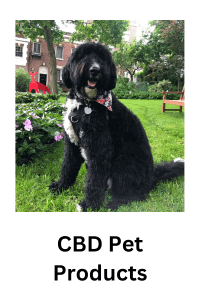If you’re a dog lover, you know how much your furry friend means to you. You want them to be happy, healthy, and comfortable. But sometimes, they may suffer from health issues that affect their quality of life, such as arthritis, pain, anxiety, or seizures.
You may have heard of CBD, a natural compound derived from hemp that has many benefits for humans. But did you know that CBD can also help your dog?
CBD stands for cannabidiol, and it’s one of the many cannabinoids found in the cannabis plant. Unlike THC, the psychoactive component of marijuana, CBD does not get you or your dog high. Instead, it interacts with the endocannabinoid system, a network of receptors and molecules that regulate various functions in the body, such as mood, appetite, inflammation, and pain.
CBD has been shown to have anti-inflammatory, analgesic, anti-anxiety, and anticonvulsant properties in both humans and animals. It can help your dog cope with various conditions, such as arthritis, chronic pain, anxiety, stress, and epilepsy. It can also improve their overall wellness and vitality.

But how do you give CBD to your dog? How much should you give them? How long does it last in their system? And what are the best CBD products for pets?
In this article, we’ll answer all these questions and more. We’ll explain everything you need to know about CBD for dogs, from its safety and effectiveness to its dosage and administration.
Whether you’re new to CBD or already a fan, these articles will help you understand how it can benefit your dog and make them feel better. Read on to discover the amazing potential of CBD for dogs!
-
What Does CBD Do for Dogs? Benefits and Uses Explained
CBD, or cannabidiol, is a naturally occurring compound found in the cannabis plant. It is a non-psychoactive component, meaning it does not cause a “high” like its counterpart, THC. CBD has become increasingly popular in recent years as a potential treatment for a variety of health conditions, including anxiety, pain, and inflammation. But what does…
-
Understanding the Side Effects of CBD in Dogs: What Pet Owners Need to Know
CBD oil has become increasingly popular in recent years, and pet owners are now turning to it as a natural way to relieve their furry friends’ pain, anxiety, and other ailments. While CBD oil can offer many benefits to dogs, it’s essential to understand the side effects of CBD in dogs. As a responsible pet…
-
The Ultimate Guide to Choosing Safe and Effective CBD Pet Products
A Quick Guide to Selection and Safety With the increasing popularity of CBD products, pet owners are exploring its potential benefits for their fur babies. This article will guide you through the process of shopping for CBD pet products, ensuring you understand different ways to administer CBD to your pets, recommended dosages, and key questions…
-
Is CBD Safe For Dogs? A Friendly Guide To Understanding The Risks And Benefits
Is CBD safe for dogs? In a word, yes! CBD has gained immense popularity in recent years for its potential health benefits in humans. But can the same be said for our furry friends? CBD, short for cannabidiol, is a compound found in the cannabis plant. Unlike THC, the psychoactive component of cannabis that produces…
-
How Long Does CBD Last in a Dog’s System? A Helplful Guide
The quick answer to this question is, on average, CBD typically stays in a dog’s system for at least 8 to 18 hours. However, the lengthier answer to this question is not straightforward and depends on several factors this article will cover. CBD has become increasingly popular in recent years as a natural remedy for…
-
Dog Arthritis CBD: A Comprehensive Guide
As a dog owner, watching your furry friend struggle with the pain and discomfort of arthritis can be heart-wrenching. The stiffness, swelling, and chronic pain associated with this condition can significantly hamper your dog’s quality of life. However, recent studies suggest that Cannabidiol (CBD), a compound found in cannabis and hemp, may offer a natural, safe, and effective…
-
CBD for Pets
Benefits and Risks of Using CBD Oil for Your Pets CBD has become increasingly popular in recent years, not just for humans but also the use of CBD for pets. CBD, or cannabidiol, is a natural compound found in the cannabis plant that has been shown to have a variety of potential health benefits. While…
-
CBD for Dogs Benefits
Discover This Natural Remedy CBD, or cannabidiol, is a natural compound found in the cannabis plant that has been gaining popularity for its potential health benefits for both humans and animals. In recent years, CBD for dogs benefits our pets suffering from a variety of health issues, including anxiety, pain, and seizures. While there is…
-
CBD for Dog Pain: A Natural Remedy?
CBD is a compound that is gaining popularity for its potential benefits in treating various ailments in both humans and animals. One of the most common reasons dog owners are turning to CBD is to help manage their furry friend’s pain. While research is still limited, many pet owners have reported success in using CBD…
-
CBD for Dog Anxiety: How CBD Can Help Calm Your Pet
Can CBD help with dog anxiety? This comprehensive guide for using CBD to treat anxiety in dogs uses anecdotal and scientific evidence to show it can. Amy V. has a dog who experiences terrible anxiety around fireworks. Amy sought help from Flourish + Live Well, a CBD store in Oceanside, CA. In her video, My…
-
CBD Dosage for Dogs: A Useful Guide
CBD has become a popular supplement for dogs, with many owners turning to it for its potential health benefits. However, determining the right CBD dosage for dogs can be tricky, as it can vary depending on the dog’s size, weight, and individual needs. In this article, we will explore the topic of CBD dosage for…
-
CBD Pet Health Benefits
A Guide to Finding Relief and Comfort In recent years, the use of CBD for pets has gained significant attention due to its potential health benefits. Emerging research suggests that CBD may help pets with various health conditions, including anxiety, chronic pain, and seizures. Although more studies are needed to confirm its benefits, many pet…
-
CBD Pet Products
CBD Pet Products A Comprehensive Guide to Safe and Effective Use Cannabidiol (CBD) pet products are becoming increasingly popular among pet owners who are looking for natural ways to improve their pets’ health and well-being. CBD is a non-psychoactive compound found in the cannabis plant that has been shown to have a variety of therapeutic…
-
Does CBD Work for Dogs?
Understanding How It Works CBD, or cannabidiol, has become a popular wellness trend for both humans and pets. While there is still limited research on the use of CBD for dogs, many pet owners have claimed that it can help treat a variety of conditions such as pain, anxiety, and seizures. But how exactly does…
-
Types of CBD Pet Products:
A Comprehensive Guide for Pet Owners As pet owners increasingly look for natural alternatives to support their furry friend’s health and well-being, the popularity of CBD pet products has surged. These products, crafted specifically for pets and infused with cannabinoids derived from hemp plants, are tailored to address a variety of issues, such as anxiety,…
-
CBD Pet Benefits
Exploring Safety, Usage, and Vet Insights In recent years, the popularity of CBD has soared not only for humans but also for pets. As pet owners become increasingly interested in holistic health options, many are turning to CBD for their furry friends. Numerous anecdotal reports and studies suggest that CBD may provide a range of…



